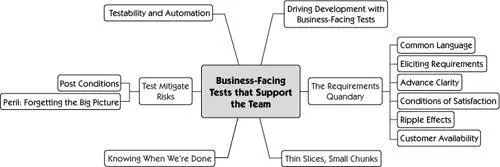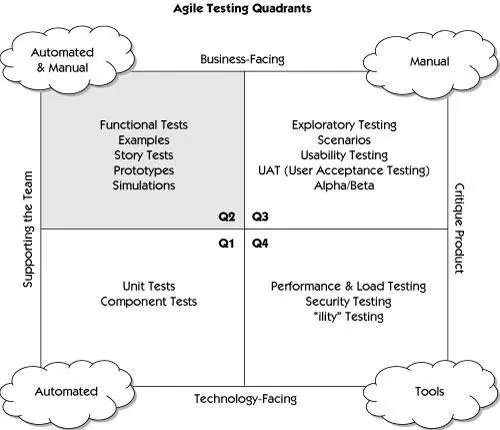Crispin, Lisa - Agile Testing - A Practical Guide for Testers and Agile Teams
Здесь есть возможность читать онлайн «Crispin, Lisa - Agile Testing - A Practical Guide for Testers and Agile Teams» весь текст электронной книги совершенно бесплатно (целиком полную версию без сокращений). В некоторых случаях можно слушать аудио, скачать через торрент в формате fb2 и присутствует краткое содержание. Год выпуска: 2008, Издательство: Addison-Wesley Professional, Жанр: Старинная литература, на английском языке. Описание произведения, (предисловие) а так же отзывы посетителей доступны на портале библиотеки ЛибКат.
- Название:Agile Testing: A Practical Guide for Testers and Agile Teams
- Автор:
- Издательство:Addison-Wesley Professional
- Жанр:
- Год:2008
- ISBN:нет данных
- Рейтинг книги:4 / 5. Голосов: 1
-
Избранное:Добавить в избранное
- Отзывы:
-
Ваша оценка:
- 80
- 1
- 2
- 3
- 4
- 5
Agile Testing: A Practical Guide for Testers and Agile Teams: краткое содержание, описание и аннотация
Предлагаем к чтению аннотацию, описание, краткое содержание или предисловие (зависит от того, что написал сам автор книги «Agile Testing: A Practical Guide for Testers and Agile Teams»). Если вы не нашли необходимую информацию о книге — напишите в комментариях, мы постараемся отыскать её.
Agile Testing: A Practical Guide for Testers and Agile Teams — читать онлайн бесплатно полную книгу (весь текст) целиком
Ниже представлен текст книги, разбитый по страницам. Система сохранения места последней прочитанной страницы, позволяет с удобством читать онлайн бесплатно книгу «Agile Testing: A Practical Guide for Testers and Agile Teams», без необходимости каждый раз заново искать на чём Вы остановились. Поставьте закладку, и сможете в любой момент перейти на страницу, на которой закончили чтение.
Интервал:
Закладка:
Without an automated build process you’ll have a hard time deploying code for testing as well as releasing. Build management and build automation tools are easy to implement and absolutely necessary for successful agile projects. Make sure you get your build process going early, even before you start coding. Experiment with different tools when you find you need more features than your current process provides.
Unit Test Tools
Unit test tools are specific to the language in which you’re coding. “xUnit” tools are commonly used by agile teams, and there’s a flavor for many different languages, including JUnit for Java, NUnit for .NET, Test::Unit for Perl and Ruby, and PyUnit for Python.
Behavior-driven development is another flavor of test-driven development, spelling out expected behavior to drive tests with tools such as RSpec and easyb.
See Chapter 9, “Toolkit for Business-Facing Tests that Support the Team,” for more information on behavior-driven development tools.
GUI code can and should be developed test-first as well. Some tools for rich-client unit testing are TestNG, Abbot, and SWTBot.
Tools such as EasyMock and Ruby/Mock help with implementing mock objects and test stubs, an integral part of well-designed unit tests.
See the bibliography for links and books to help your team search for the right unit test tools.
The tools programmers use to write technology-facing tests can also be used for business-facing tests. Whether they are suited for that purpose in your project depends on the needs of your team and your customers.
Summary
In this chapter, we explained the purpose of technology-facing tests that support the team, and we talked about what teams need to use them effectively.
 Technology-facing tests that support programming let the team produce the highest quality code possible; they form the foundation for all other types of testing.
Technology-facing tests that support programming let the team produce the highest quality code possible; they form the foundation for all other types of testing.
 The benefits of this quadrant’s tests include going faster and doing more, but speed and quantity should never be the ultimate goal.
The benefits of this quadrant’s tests include going faster and doing more, but speed and quantity should never be the ultimate goal.
 Programmers write technology-facing tests that support the team and provide great value to testers by enhancing the internal quality and testability of the system.
Programmers write technology-facing tests that support the team and provide great value to testers by enhancing the internal quality and testability of the system.
 Teams that fail to implement the core practices related to agile development are likely to struggle.
Teams that fail to implement the core practices related to agile development are likely to struggle.
 Legacy systems usually present the biggest obstacles to test-driven development, but these problems can be overcome with incremental approaches.
Legacy systems usually present the biggest obstacles to test-driven development, but these problems can be overcome with incremental approaches.
 If your team doesn’t now do these tests, you can help them get started by engaging other team members and getting support from management.
If your team doesn’t now do these tests, you can help them get started by engaging other team members and getting support from management.
 There can be some overlap between technology-facing tests and business-facing tests that support the team. However, when faced with a choice, push tests to the lowest level in order to maximize ROI.
There can be some overlap between technology-facing tests and business-facing tests that support the team. However, when faced with a choice, push tests to the lowest level in order to maximize ROI.
 Teams should set up continuous integration, build, and test processes in order to provide feedback as quickly as possible.
Teams should set up continuous integration, build, and test processes in order to provide feedback as quickly as possible.
 Agile teams require tools for tasks such as source code control, test automation, IDEs, and build management in order to facilitate technology-facing tests that support the team.
Agile teams require tools for tasks such as source code control, test automation, IDEs, and build management in order to facilitate technology-facing tests that support the team.
Chapter 8 Business-Facing Tests that Support the Team

In the last chapter, we talked about programmer tests, those low-level tests that help programmers make sure they have written the code right. How do they know the right thing to build? In phased and gated methodologies, we try to solve that by gathering requirements up front and putting as much detail in them as possible. In projects using agile practices, we put all our faith in story cards and tests that customers understand in order to help code the right thing. These “understandable” tests are the subject of this chapter.
Driving Development with Business-Facing Tests
Yikes, we’re starting an iteration with no more information than what fits on an index card, something like what’s shown in Figure 8-1.
Figure 8-1 Story to set up conversation

That’s not much information, and it’s not meant to be. Stories are a brief description of desired functionality and an aid to planning and prioritizing work. On a traditional waterfall project, the development team might be given a wordy requirements document that includes every detail of the feature set. On an agile project, the customer team and development team strike up a conversation based on the story. The team needs requirements of some kind, and they need them at a level that will let them start writing working code almost immediately. To do this, we need examples to turn into tests that will confirm what the customer really wants.
These business-facing tests address business requirements. These tests help provide the big picture and enough details to guide coding. Business-facing tests express requirements based on examples and use a language and format that both the customer and development teams can understand. Examples form the basis of learning the desired behavior of each feature, and we use those examples as the basis for our story tests in Quadrants 2 (see Figure 8-2).
Figure 8-2 The Agile Testing Quadrants, highlighting Quadrant 2

Business-facing tests are also called “customer-facing,” “story,” “customer,” and “acceptance” tests. The term “acceptance test” is particularly confusing, because it makes some people think only of “user acceptance tests.” In the context of agile development, acceptance tests generally refer to the business-facing tests, but the term could also include the technology-facing tests from Quadrant 4, such as the customer’s criteria for system performance or security. In this chapter, we’re discussing only the business-facing tests that support the team by guiding development and providing quick feedback.
As we explained in the previous two chapters, the order in which we present these four quadrants isn’t related to the order in which we might perform activities from each quadrant. The business-facing tests in Quadrant 2 are written for each story before coding is started, because they help the team understand what code to write. Like the tests in Quadrant 1, these tests drive development, but at a higher level. Quadrant 1 activities ensure internal quality, maximize team productivity, and minimize technical debt. Quadrant 2 tests define and verify external quality, and help us know when we’re done.
Part V, “An Iteration in the Life,” examines the order in which we perform tests from the different quadrants.
Читать дальшеИнтервал:
Закладка:
Похожие книги на «Agile Testing: A Practical Guide for Testers and Agile Teams»
Представляем Вашему вниманию похожие книги на «Agile Testing: A Practical Guide for Testers and Agile Teams» списком для выбора. Мы отобрали схожую по названию и смыслу литературу в надежде предоставить читателям больше вариантов отыскать новые, интересные, ещё непрочитанные произведения.
Обсуждение, отзывы о книге «Agile Testing: A Practical Guide for Testers and Agile Teams» и просто собственные мнения читателей. Оставьте ваши комментарии, напишите, что Вы думаете о произведении, его смысле или главных героях. Укажите что конкретно понравилось, а что нет, и почему Вы так считаете.












